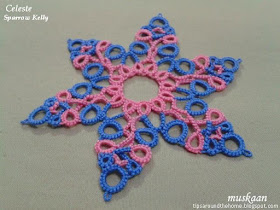tatted snowflake with Celtic effect
Has this happened to you ? Some patterns tend to reveal themselves gradually, layer by onion layer, despite the fact that the designer has presented the pattern clearly, with superb diagram, instructions and a tatted model ?!
Has this happened to you ? Some patterns tend to reveal themselves gradually, layer by onion layer, despite the fact that the designer has presented the pattern clearly, with superb diagram, instructions and a tatted model ?!
This is one such . And each layer brought clarity, simplification, and joy :-)
I had to retro-tat segments a few times, until the elegance of this design gradually made it into me thick skin.
Celeste
Sparrow Kelly
I love the Celtic effect and
elegance of this pattern! Not for the faint-hearted, but one soon gets into the
rhythm & I enjoyed the challenge.
I had started with the maroon and blue, but made a mistake in the 2nd repeat. Following the diagram exactly, this is what we get on the 2nd repeat – an extra chain and a visible picot. Unlike what the diagram says, Ring J is the equivalent of Ring A, where the repeat starts.
The diagram and presentation is very
appealing & the layering of chains is clearly visible in her diagram.
I had started with the maroon and blue, but made a mistake in the 2nd repeat. Following the diagram exactly, this is what we get on the 2nd repeat – an extra chain and a visible picot. Unlike what the diagram says, Ring J is the equivalent of Ring A, where the repeat starts.
I started again, this time with
pink hoping that the crossover layers will show better in a lighter colour.
My Notes
- Overall, the snowflake is worked counterclockwise.
- For frontside/backside tatting, all grey
coloured elements are tatted backside.
- Ring J is actually the equivalent of ring A, hence
next repeat starts from ring J.
- Her tatted model has one extra ring in the
inner circle (13 instead of 12, which caused me a lot of confusion. 13
didn’t make sense, yet it was difficult to locate the extra ring - found it finally at 10 o'clock position).
- Always remember to bring both threads to the
front after ring H so that the chain is above Ch3 (this is a note to
myself, coz I had to retrotat on many occasions!)
- Also important skill required - how to join
last ring to first. It is a bit tricky in this pattern, especially when
the ring is small (more below).
- Some rings and chains require switching shuttles to get colours into position. SS after ring B, Ch3, Ch4, ring G, ring H, ring I, and Ch9 .
- I used direct tatting (reverse stitch) for some of the short chains, especially between the three rings at the tips.
- UPDATE Shuttles are numbered & colour-coded according to the colour of stitches that show up, not necessarily the shuttle that forms the core thread. Hence green rings will use the green shuttle, but green chains will be made with the grey shuttle.
Thesee layers revealed themselves gradually. The one layer that remains hidden
is how Kelly came up with this synchronised design. Simple rings and chains, no SLTs or Celtic
shuttles…. Would be interesting to get
a peek into her gray matter, right ?!
Incidentally, I had to peel off
layers to find the source of this pattern, too, which I had downloaded a while
back. Googled Images, then found Kelly’s blog, (but pattern is no longer there), and her post where she mentioned
it was being shared with the OTC. Got the date/month/year and hunted the 2011 OTC index. No image, but thankfully the pdf link was there (April 2011).
There are many ways to avoid the folded join (and I always avoid). Some of these tutorials are listed here.
But this pattern had a different
dilemma. (Not sure whether it was due to frontside/backside
tatting, a small ring, or fine thread, hmm or my thick-headedness). :
- the ‘first’ ring was on the left of the current ring ;
- the rings were facing outwards
- avoiding a colour blip and using an up &/or down loop
UPDATE (May 10, 2017) : A video showing last to first join has been shared by Sandra Figg. Note the way she rotates the motif to orient the 2 rings correctly. This same concept of reorientation is applicable to outward facing rings or rosettes.
Many many thanks to Kelly for this
wonderful pattern !
happy tatting :-)





Very intricate, an interesting effect.
ReplyDeletea bit of a challenge tatting it too, Jane, and that's why I like it even more :-)
DeleteAh!!! Love the colors n pattern tooo Muskaan. Your detailed working on each pattern is very useful. Thanks.
ReplyDeleteThanks, Usha :-)
DeleteVery interesting pattern, thanks for the link. I've saved it to iBooks so I can look at it later to see how those chains were made! I've also made a mental note of the corrections you've listed above :)
ReplyDeleteThis will prove a challenge for me I'm afraid, but I like it very much. I'll try anyway. Thanks for your tips :)
ReplyDeleteVery interesting snowflake with Celtic effect. Thanks for the link and your tips :)
ReplyDeleteGorgeous snowflake!!! :)
ReplyDeleteBeautiful snowflake interesting pattern
ReplyDeleteI have added one more tip in my notes for those interested in tatting this beautiful pattern. So please make a note of it in your files.
ReplyDeleteTruly appreciate all your lovely words - I am so glad you like it :-)
Have a great day, dear friends!
Beautiful and well explained.
ReplyDeleteThanks Bernice :-)
Delete